Boer War (1900 to 1902)
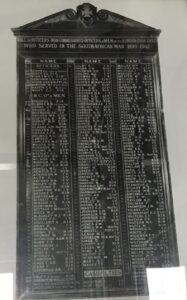 Following some months of disagreement, the two Boer Republics, namely the Transvaal and the Orange Free State, declared war on the British forces in South Africa on 8th September 1899.
Following some months of disagreement, the two Boer Republics, namely the Transvaal and the Orange Free State, declared war on the British forces in South Africa on 8th September 1899.
Captain WC Olpherts, Adjutant of the 16th Middlesex Volunteers (London Irish) Rifles, who had been in contact with another officer, Mr WF Monypeny, an enthusiastic officer within ‘H’ Company of the London Irish, and a former assistant editor of the Times, circulated a notice asking for volunteers to:
- Serve with regular troops abroad, if required, with the possibility that if sufficient numbers came forward they could be kept together as a London Irish detachment or company in one of the Irish regiments under orders for the front,
- Undertake garrison duties in the UK and so replace regular units…..
First World War
Battle of Loos (September 1915)
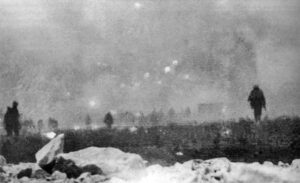 On Saturday 25th September 1915, three divisions of 4 Corps took part in a general attack centred on the village of Loos. The London Irish Rifles were in a division composed of London Territorials and were given the responsibility and honour of leading their Brigade, which in turn led their Division. As a result of the battle, a double line of Germans trenches was cleared along a front of four miles and to a depth at its greatest of four miles. The whole of this area, some twelve square miles around the village of Loos, was a desperate network of trenches and bomb proof centres….
On Saturday 25th September 1915, three divisions of 4 Corps took part in a general attack centred on the village of Loos. The London Irish Rifles were in a division composed of London Territorials and were given the responsibility and honour of leading their Brigade, which in turn led their Division. As a result of the battle, a double line of Germans trenches was cleared along a front of four miles and to a depth at its greatest of four miles. The whole of this area, some twelve square miles around the village of Loos, was a desperate network of trenches and bomb proof centres….
Vimy Ridge (March to October 1916)
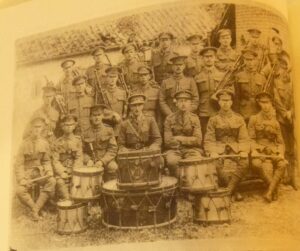 December 1915 was a particularly hot time in the Hohenzollern Redoubt with mine warfare. 14 men died when a platoon of A Company was buried on Christmas Eve. In January 1916, the London Irish were back in the centre of Loos. Trench strength of the battalion was down to 16 officers and 381 men again as the year began. The London Irish moved to Raimbert in mid February, where the Battalion Concert Party was formed, and was named the ‘Emeralds.
December 1915 was a particularly hot time in the Hohenzollern Redoubt with mine warfare. 14 men died when a platoon of A Company was buried on Christmas Eve. In January 1916, the London Irish were back in the centre of Loos. Trench strength of the battalion was down to 16 officers and 381 men again as the year began. The London Irish moved to Raimbert in mid February, where the Battalion Concert Party was formed, and was named the ‘Emeralds.
In the spring of 1916, the 1st Battalion moved forward to the Souchez area to take over from the French. The London Irish line was in the Carency sector on the extreme left of Vimy Ridge. This sector remained relatively quiet at first although enemy shell fire was troublesome. During April, while in reserve, the London Irish suffered an epidemic of measles starting with D Company and all of these men had to be isolated. Fifteen men were killed by shell fire during the first four months of 1916…
High Wood (September 1916)
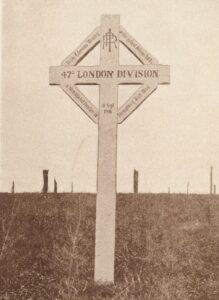 The 1st Battalion moved a short distance to the Amiens-Albert road and marched eastwards to Albert on 11th September 1916. From there, the Battalion moved to the support area around Bottom and Mametz Wood. Few trees remained in a mass of splintered timber as these woods were on the fringe of the great battle of the Somme, which had lasted throughout the months of July and August. Fearful casualties had been suffered by both sides but little territory had been gained.
The 1st Battalion moved a short distance to the Amiens-Albert road and marched eastwards to Albert on 11th September 1916. From there, the Battalion moved to the support area around Bottom and Mametz Wood. Few trees remained in a mass of splintered timber as these woods were on the fringe of the great battle of the Somme, which had lasted throughout the months of July and August. Fearful casualties had been suffered by both sides but little territory had been gained.
The London Irish were to participate in a major attack by 4th Army and their task was to seize the high ground at Bois de Fourneaux, better known as High Wood, which already had an evil reputation…
Ypres Front (November 1916 to September 1917)
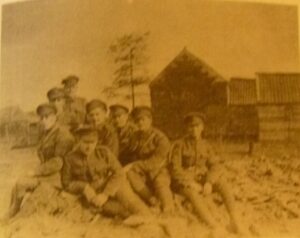 The rest of October 1916 was spent in the 1st Battalion moving from the Somme to the Ypres region and in training. The London Irish entered the line again at Ravine Wood on the 8th November sustaining casualties from shell fire on the following nine days, 2/Lieut Stedman and eleven other ranks being killed.
The rest of October 1916 was spent in the 1st Battalion moving from the Somme to the Ypres region and in training. The London Irish entered the line again at Ravine Wood on the 8th November sustaining casualties from shell fire on the following nine days, 2/Lieut Stedman and eleven other ranks being killed.
The danger was that Hill 60, from which the sector derived its name, rose gently in the enemy lines providing valuable observation of the British trenches. The Germans had occupied this position since the early days of the war and converted it into an almost impregnable fortress. When the London Irish returned to the line at the end of January 1917, the snow covered ground made every movement conspicuous, and white smocks were issued. A considerate Brigade HQ authorised a double rum ration in an attempt to ameliorate the severe conditions. In mid February, the Bombing Platoon was disbanded after a year and a half of magnificent success, and the bombers returned to their companies. Lieut Col Mahon was forced to leave through illness and the command was taken over by Major DB Parry, who was later confirmed in the position as Lieut Colonel…
Bourlon Wood (November/December 1917)
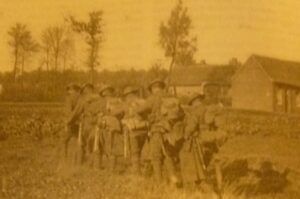 September 1917 saw the end of the 1st Battalion’s work in the Ypres area as on the 21st, the 47th Division moved south to join the 1st Army near Arras. On the 19th November 1917, orders were received to move again to prepare for the battle of Bourlon Wood.
September 1917 saw the end of the 1st Battalion’s work in the Ypres area as on the 21st, the 47th Division moved south to join the 1st Army near Arras. On the 19th November 1917, orders were received to move again to prepare for the battle of Bourlon Wood.
In the spring the Germans had retired to the newly constructed Hindenburg Line methodically destroying everything as they went. The region, in which the London Irish found itself was one of utter devastation. The Hindenburg Line consisted of a heavily wired continuous line of entrenchments, which comprised all the high ground west of Cambrai….
Egypt & Palestine (1917/18)
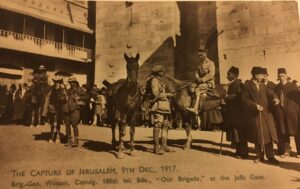 The 2nd Battalion landed at Alexandria on 12th June 1917, where they joined a train for Ismalia. From there, they moved by stages to Kantara, Sheik Nuran and El Shauth. At the last named, the Battalion spent three months training in desert conditions, without meeting the enemy, which was, of course, the Turks.
The 2nd Battalion landed at Alexandria on 12th June 1917, where they joined a train for Ismalia. From there, they moved by stages to Kantara, Sheik Nuran and El Shauth. At the last named, the Battalion spent three months training in desert conditions, without meeting the enemy, which was, of course, the Turks.
Their first action was on the last day of October during the attack on Beersheba, when the London Irish were in the reserve brigade. The first battle honour for the regiment in this campaign was ‘El Mughar’, awarded for the Battle of Sheria on 6th November, 1917….
Northern France (March/April 1918)
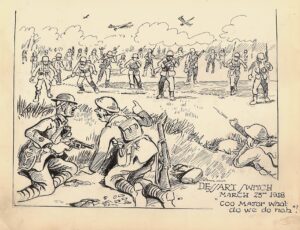 Early 1918 was taken up by a reorganisation but by the beginning of March, it was certain that a big German offensive was underway and that it would be soon. An intense enemy bombardment starting at 4am on 21st March signalled the enemy offensive.
Early 1918 was taken up by a reorganisation but by the beginning of March, it was certain that a big German offensive was underway and that it would be soon. An intense enemy bombardment starting at 4am on 21st March signalled the enemy offensive.
The London Irish were in the La Vacquerie sector, south west of Cambrai and about two miles south of the most forward point of the Flesquieres salient. The main assaults of the German spring offensive were north and south of this salient but the danger lay in being outflanked….
The Final Few Months of The Great War (1918)
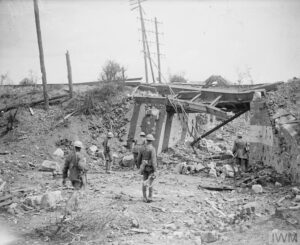
May and June 1918 were spent in and out of the line south west of Albert. There was some enemy artillery and 2/Lieut Downes and twelve other ranks were killed during these two months. In June, each London Irish company had the pleasure of training a platoon of American soldiers in the line. On August 1st, the enemy withdrew east of the River Ancre and London Irish patrols were able to enter Albert during daylight. By 9th August, after many London Irish patrol attacks, few Germans remained in Albert….
Second World War
Hill 286 – Bou Arada (January 1943)
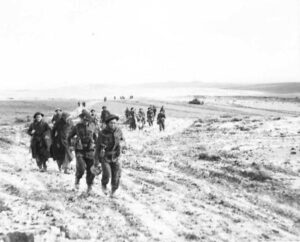
The Battle of Bou Arada was a bloody affair in which the 2nd Battalion, London Irish distinguished themselves, but with grievous losses. The night of 19th January 1943 had been spent just outside El Aroussa, and the next night the battalion moved into the plains to the west of Bou Arada. Another move was ordered, but no sooner had the battalion finished digging that they had to move once more. In fact the London Irish moved four times in four nights, and everyone became tired. On the morning of the 19th, they marched in extended line across the open plain via Bou Arada. Their job was to guard the brigade’s one line of communication, the lateral road from Bou Arada to Grandstand Ridge…
Stuka Ridge (February 1943)
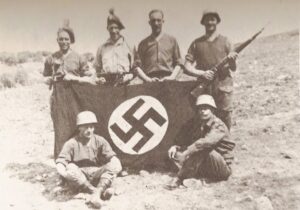
Mid-February saw much movement and change to meet German thrusts in the Kasserine. The result of that was to leave a scratch force in the Bou Arada Plain, to be known as “Y Division,” and consisting of the Irish Brigade, a Paratroop Brigade, a French battalion, and artillery. Brigadier Nelson Russell was placed in command, and one of the first things he did was to form a reserve of a squadron of Churchills, a squadron of the Derbyshire Yeomanry, and the Royal Irish Fusiliers. The remaining battalions were already stretched over a wide area and the respective commanders disclaimed all responsibility for forcibly extended fronts. The danger of the Djebel Rihane was obvious.It was a great mass of wooded, precipitous mountain country to the left and rear of the brigade. It could conceal two army corps but had no real tracks, so supply would be a problem. If the enemy could get there and maintain himself, the Irish Brigade, and indeed the whole of Y Division, would be in a predicament. The enemy would be behind the infantry positions and could look down on the gun lines. That weakness was apparent to all….
Heidous (April 1943)
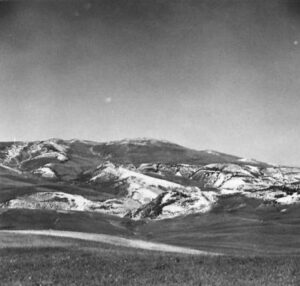
In April 1943, the plan was now ready for the final push in the mountains by the 78th Division, preparatory to the break-through by the armour along the Medjez road to Tunis. The preliminary operation was necessary in order to clear and remove the threat to the Tebourba road. The Irish Brigade was to capture Tanngoucha and the village of Heidous, and 36 Brigade to capture the famous fortress of Longstop Hill which commanded the road. The Commanding Officer gave out his orders for the attack on Heidous during the afternoon of 22nd April. It was in two phases. First, ’F’ Company were to clear the village itself, supported by ‘G’ Company, whose task was to take a small feature on the right; second, E Company and H Company were to clear Sandy Ridge, east of Heidous…
Fosso Bottaceto – Simeto River Bridgehead (July 1943)
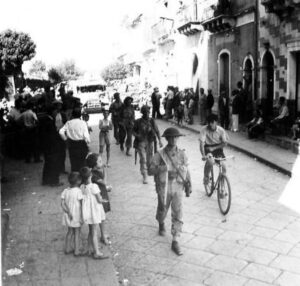
In early July 1943, the British Eighth Army, fresh from their triumph in North Africa, landed on the beaches of the east coast of Sicily, south of Syracuse, the ancient city founded by the Corinthians several centuries before Christ. The port, scene of stirring battles between the Athenians and the Syracusans, was captured and was quickly made ready to receive the reinforcements which followed up behind the assault troops. The historic old city had escaped devastation. The next objective was the Catania Plain and its spacious airfields, thence east and west of Mount Etna, to converge again in the neighbourhood of Taormina. The American Seventh Army landed on the south coast near Gela and proceeded towards Palermo and Marsala on the west side of the island…
Centuripe to Randazzo (August 1943)
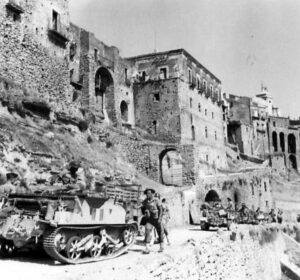
The key position in the German defence line across Sicily was Centuripe, a village perched on the top of a formidable line of steep hills. Its precipitous sides gave it an almost impregnable position. The lesser hills round it were well defended by the enemy and it was necessary for them to be mastered before Centuripe could be tackled.
The 78th Division got together for a drive towards Catenanuova and to capture Centuripe. The country between the two villages was wild and extremely rough. Great rocky crags, similar to those among which the 2nd Battalion had fought in North Africa, covered the one mountain road between them. The Irish Brigade had to take Centuripe, and the scheme was for a silent night advance to be made with heavy gun-fire available at call. The 6th Royal Inniskilling Fusiliers and the Royal Irish Fusiliers were given the main tasks, and the 2nd Battalion London Irish were ordered to make a dangerous flank secure….
Termoli (October 1943)
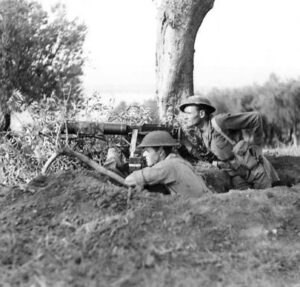
The invasion of southern Italy continued steadily but slowly. Along the Adriatic coast it was particularly slow, because the Germans were blowing up every bridge, culvert, and road, and as there was a bridge almost every half-mile along the only main road of the coast the German plan to delay the Eighth Army worked only too well. To prevent further delay and to expedite the invasion it was decided to land a force at Termoli, farther up the coast, and thus force the Germans to give ground in the south. The Irish Brigade took part in this move, and when they sailed from Barletta on the morning of 5th October everyone looked forward to a pleasant sea cruise with maybe a few quiet days at Termoli. But those days were not so quiet, for the reason that Termoli was well garrisoned by the Hun…
River Trigno (October 1943)
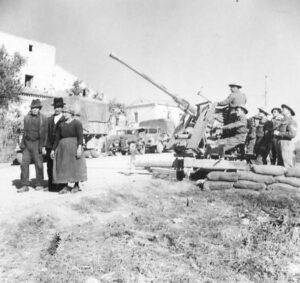
The next obstacle was the River Trigno, about seven thousand yards from Petacciato. On the whole it was shallow, about five feet in its deepest part, with odd sandstone patches in mid-stream. It was wide, with scrub and cover on the south side, and thickly wooded on the opposite side. The main bridge across it was still intact, but the problem whether or not a charge had been laid was not cleared up until the sappers with a platoon from E Company went down and after a short scrap with German rearguards reported that it was safe, so far as they could tell, but a thorough inspection was impossible…
Sangro River (November/December 1943)
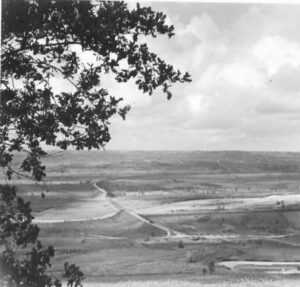
In the middle of November 1943, the 2nd Battalion went out of the line while the two other brigades of the 78th Division swept on to the Sangro, along the north bank of which the enemy had built powerful defences. It was a good defence-line, with the ground forming several natural intermediate outposts. There was the river itself, fast flowing from the incessant rain and the melting snow on the hills. It was deep, with an average width of one hundred feet. The exact distance could not be accurately determined because the flow and height of the torrent varied overnight. During the day the river might be fordable, but after rain had fallen, it would rage along, flooding its banks, and become not a hundred feet, but a hundred yards wide…
Monte Camino (December 1943)
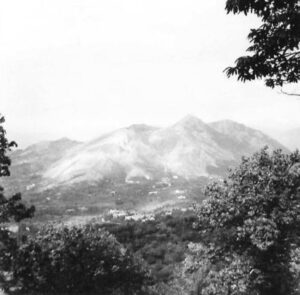
In early December 1943, news then came that the 56th (London) Division had been selected to take part in a further attack on Monte Camino, the operation coinciding with an attack by the Americans on the twin feature of Monte la Difensa. Monte Camino, rising a sheer three thousand feet from the surrounding valleys, was crowned with a small monastery, and the whole feature was about six thousand yards wide and seven thousand yards in depth. The Americans were on the north-east section and the British on the south-east. The mountain was rocky, steep, and bare, and on the British side the only approach for laden men was up a steep, zigzag mule-track leading from a village called Mieli. The existence of this track was well known to the Germans and was marked on all the maps…
Castelforte – Garigliano River (January 1944)
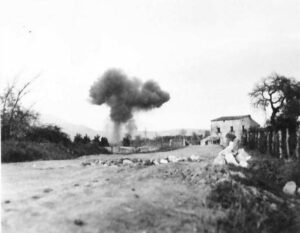
The plan for the operation, in the middle of January 1944, was for the 46th Division to attack on the right and capture high ground beyond the river; the 5th Division, which had been transferred from the Adriatic front, was to move on the left; and in the centre, 167 and 169 Brigades were to cross through 168 Brigade, which was to follow them over. On the 46th Division sector the hills rose straight from the river; on the other two sections there was a plain between one thousand and three thousand yards deep before the ground rose sharply. This plain extended for about ten thousand yards from the sea on the west…
Anzio (February/March 1944)
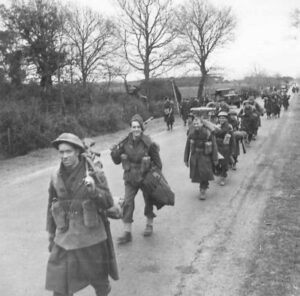
Towards the end of 1943, the weather throughout the battle areas was appalling and the enemy, profiting by the mountainous country, the snow, rain, and mud, the poor roads and the flooded valleys, had successfully slowed up and eventually halted the Allied advance along the whole Italian front, from the Apennines to the sea. The natural defences north and south of Cassino and the lower Garigliano Valley gave the enemy an advantage, and here the Germans established the strong Gustav Line, manned by many new troops, notably highly trained mountain fighters. Their firm resistance showed that they intended to stand on that line for the rest of the winter…
Sinagoga – Liri Valley (May 1944)
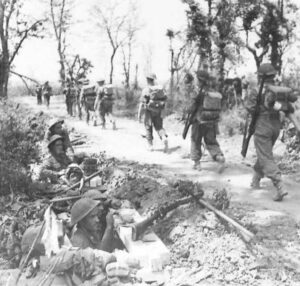
The Big Push to Rome was to begin in the middle of May 1944, and it would be the prelude to the Invasion of Europe in Normandy. None of the previous attempts to break through the German lines at the Garigliano, the Rapido, and at Cassino had met with complete success, and the time had now arrived for an effort which MUST succeed. The plan was to attack between Cassino Monastery and the sea on a frontage of about nineteen miles. Everything to the north was to be held as lightly as possible so that a big concentration of troops and supporting arms was available…
Sanfatucchio – Lake Trasimene (June 1944)
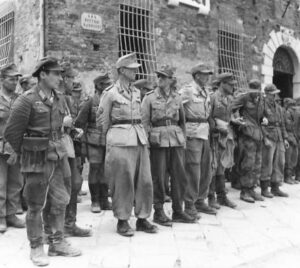
The London Irish continued to move forward, and on 18th June 1944 went across the mountains in very bad weather to Monte Giove. The following day worse tracks led them to Tavernelle. In that area, on either side of Lake Trasimeno, the Germans had decided to make a stand, and were holding a line in great strength from Chiusi and San Fatucchio, to the lake on the west side and Perugia on the east. After three days of exhausting fighting the other two brigades of the 78th Division had been finally stopped south of San Fatucchio, and the London Irish were given the task of breaking through at that point and striking as far north as possible…
Gothic Line (September 1944)
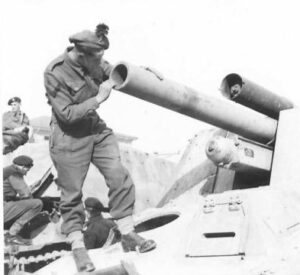
On 30th August 1944, the 1st Battalion moved up once again through Sassoferrato to Urbino. By that time the battle was on and was going well. The prepared defences were swept aside and it looked very much as if the Gothic Line had been broken. By 1st September, the division was committed, with 168 Brigade in reserve. On 4th September, he London Irish moved up, and then it became clear that all was not going as well as had been hoped. The Queen’s and 167 Brigade were having trouble. Some unpleasantly high features were proving a nuisance, and the River Conca was ahead….
Monte Spaduro (October 1944)
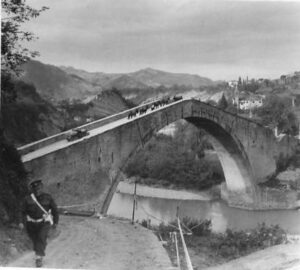
The centre of gravity in the fighting seemed to pass to the Eighth Army front by October 1944. With a little more strength, the Allied Armies might have accomplished more in the attack towards the River Po before the autumn and winter rains set in, but it was revealed by General Alexander afterwards that some American and French Divisions had been withdrawn from Italy for the attack on the south of France and this had weakened his forces. To drive the Germans from the Po Valley during the winter could hardly be expected…
Lake Comacchio – Reno River (April 1945)
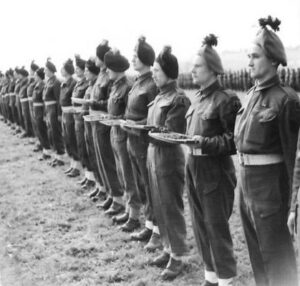
It was hoped to destroy the German armies south of the Po by a pincers movement, with the Eighth Army advancing on a general axis through Argenta, Ferrara, and Bodeno, and the US led Fifth Army attacking north through Bologna to the river near Ostiglia. The Fifth Army was then to drive towards Verona and cut off the whole of the enemy forces in north-west Italy. To enable the maximum use to be made of the Allied Air Forces, the attacks were to be on different dates, the Eighth Army going into action at least three days before the Fifth Army, which it was thought would draw off any enemy reserves from the Fifth Army front. The Eighth Army, after reaching the Po, was to drive north-east towards Venice and Trieste…
Argenta Gap (April 1945)
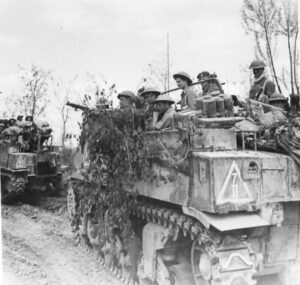
Along the winding banks of the Senio, Wasps and Crocodile flame-throwers went forward and sprayed the enemy posts with fire. Seven hundred bombers overhead laid with great accuracy a carpet of fragmentation bombs about three thousand yards west of the river. the 5th Corps went across on the right and the 2nd Polish Corps on the left. The 2nd New Zealand Division attacked a big bend of the Senio west of Cotignola and made a big wheel to the left. The 8th Indian Division went over south of Lugo. Both divisions, fighting with great spirit, reached the Santerno, and the 78th Division was then called in. It had been in reserve and it moved forward between the New Zealanders and the Indian Division. 36 Brigade pushed on at night and a bridgehead over the Santerno was secured…